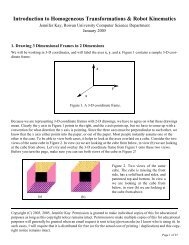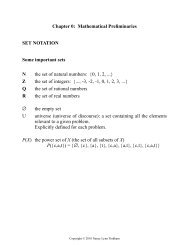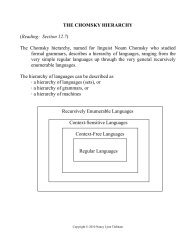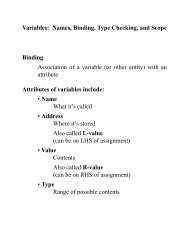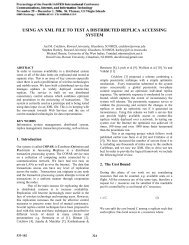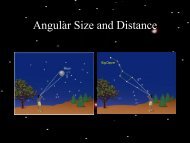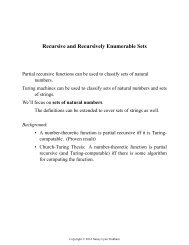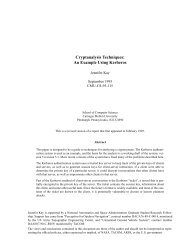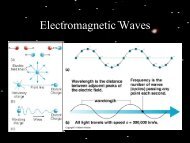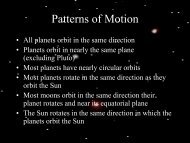Centripetal Force - Elvis.rowan.edu
Centripetal Force - Elvis.rowan.edu
Centripetal Force - Elvis.rowan.edu
You also want an ePaper? Increase the reach of your titles
YUMPU automatically turns print PDFs into web optimized ePapers that Google loves.
<strong>Centripetal</strong> <strong>Force</strong>IntroductionNewton’s first law tells us that, in the absence of any external forces, all objects will move with constantvelocity, and thus travel in a straight line. This means that for an object to move with uniform circularmotion, there must be an external force applied which pulls the object around. In this lab we will investigatethe centripetal force and its relation to the radius and speed of the motion.EquipmentProc<strong>edu</strong>re• <strong>Centripetal</strong> force apparatus • Mass set • Mass hanger • Stopwatch• Level • Ruler •Mass scaleAnalyze the ExperimentFor an object moving with uniform circular motion, the speed at which it travels is constant so we cancalculate it using the definition of the average velocity and we getv = ∆s∆t = 2πRTwhere R is the radius of the circular motion and T is the time it takes the object to go once around thecircle and is known as the period of the motion. The centripetal acceleration and force we get from:a c = v2RF c = ma c = mv2RConsider the above equation. For a givencentripetal force, what must happen to R if wetry to move with a higher v? For a given centripetalforce and radius (say, a curve in theroad), what must happen to v if we increasem (e.g. which can make the curve at a higherspeed, a Mac truck with trailer or a Geo Metro)?For a given radius, what must happen to F c ifwe decrease/increase v? These are the kinds ofrelationships we want to investigate here in thelab.Now look at the <strong>Centripetal</strong> <strong>Force</strong> Apparatus—there should be a bob hanging from a stringfrom a horizontal rod. A spring runs fromthe center upright rod and connects to thebob which will provide us with a centripetalforce later in the experiment. For now, unhookthe spring and spin the central rod slowly andsteadily. What happens to the bob? What provides the centripetal force? Try spinning it faster, but stillsteadily. What happens to the bob? Is the centripetal force the same? Is the radius of the motion the same?Is the velocity the same? Do your answers to these questions make sense in light of the centripetal forceequation above?1
The ExperimentIn order to calculate the centripetal force, F c , provided by the spring as the bob moves with uniform circularmotion we will need to know the centripetal acceleration, a c . To get that, we need to know both R, whichwe can set and measure directly, and v. To get the velocity we can use the radius we set and the period,T , of the motion. Thus, in order to calculate F c , we need to be able to measure T of the motion. The bestway to do this is to spin the system so the bob moves out to its predetermined R, then time the motion forsome large number, N times around (say, 50, 60, or 75 times). The stopwatch will give you the time, t, forN rotations—since the period, T , is just the time for one revolution we get T = t/N. So, once you measureT and R, you can calculate v, then a c and finally F c .With the spring unhooked from the bob, slide the horizontal rod so that the bob hangs over one ofthe inner three points on the measured scale—the number will be R in centimeters. Take the bob off thestring and measure its mass then replace it. Reconnect the spring and begin spinning center rod. Get itmoving fast enough that the bob hangs vertically over that same point and once you are comfortable withthe consistency of your spinning, time it for N revolutions. You can do this by having someone else watchthe bob—when it passes the pin they can indicate to have the stopwatch started. They can then count therevolutions and upon getting to N warn the timer then say stop when N is actually reached. Record bothN and t. Do this two more times, switching tasks within your group. You can then calculate T for each trialand an average T . Be sure to calculate an RMS for this period to give you some idea of the precision of yourexperiment. Using T and R calculate v, then a c and finally F c .In this experiment it is possible to directly measure the force of the spring. If you run the string attachedto the side of the bob over the pulley you can attach a mass hanger and place masses on it until the bob isstationary over the same point as above. Note the total mass and calculate its weight (F w = mg). Convinceyourself through a free-body diagram of the bob and a free-body diagram of the hanging mass that thisweight must be equal to the spring force. Then compute the ∆% between this value and the experimentalvalue above. Is it “large” (i.e. more than about 10%)? Is it small enough to indicate good accuracy (i.e.less than about 5%)? How much do you think your precision affects your accuracy?Now unhook the spring and make sure the bob still hangs over the same point. Now add some mass tothe bob and repeat the experiment getting an experimental F c , a direct measurement of the spring force,and a ∆%. How does it compare to your results above? Does this make sense given the centripetal forceequation? Compare your free-body diagrams in the two parts and see if that helps you understand yourresults.Once again, unhook the spring and move the horizontal rod out so that the bob hangs over one of thethree furthest points. Remove the excess mass, reconnect the spring and do the experiment one more timeto get an F c , a direct spring force measurement, and a ∆%. Compare this centripetal force to the others—Rhas increased and what has happened to v and F c ? Does this make sense given the formula for F c at thebeginning? How do the spring forces compare? Does this help you understand your results?Additional Thoughts1. In these experiments, the centripetal force is being provided by a spring. Look through your textbookto find a formula for the force of a spring as a function of how much it is stretched. Does this formulahelp you understand your results above?2. Looking at the centripetal force function, what must happen to v if both R and F c increase at thesame time? How does this apply to your experiment? Does it help explain your results?3. In our solar system, the centripetal force keeping the planets in their obits is gravity. It can be foundthough careful observation that planets that have a small R (closer to the Sun) have higher v and thosewith larger R (far from the Sun) have smaller v. What does this tell you about the gravitational forceas a function of R?2




